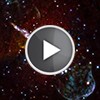CXC Home | Search | Help | Image Use Policy | Latest Images | Privacy | Accessibility | Glossary | Q&A
A New Look at an Old Friend
Quicktime MPEG With closed-captions (at YouTube)
Just weeks after NASA's Chandra X-ray Observatory began operations in 1999, the telescope pointed at Centaurus A (Cen A, for short). This galaxy, at a distance of about 12 million light years from Earth, contains a gargantuan jet blasting away from a central supermassive black hole.
Since then, Chandra has returned its attention to this galaxy, each time gathering more data. And, like an old family photo that has been digitally restored, new processing techniques are providing astronomers with a new look at this old galactic friend.
This new image of Cen A contains data from observations, equivalent to over nine and a half days worth of observing time, taken between 1999 and 2012. In this image, the lowest-energy X-rays Chandra detects are in red, while the medium-energy X-rays are green, and the highest-energy ones are blue.
As in all of Chandra's images of Cen A, this one shows the spectacular jet of outflowing material that is generated by the giant black hole at the galaxy's center. The new image also highlights a dust lane that wraps around the waist of the galaxy. Astronomers think this feature is a remnant of a collision that Cen A experienced with a smaller galaxy millions of years ago.
In addition to allowing for the creation of new images, the data housed in Chandra's extensive archive on Cen A provide a rich resource for a wide range of scientific investigations. For example, just last year researchers published new findings on the point-like X-ray sources in Cen A. They found that these sources had masses that fell into two categories. These separate groups correspond to systems where either a neutron star or a black hole is pulling material from a companion star. Information like this may tell us important details about the way the massive stars explode, and gives us even more reason to appreciate this new view of a familiar object.
[Runtime: 02:22]
Quicktime MPEG With closed-captions (at YouTube)
Just weeks after NASA's Chandra X-ray Observatory began operations in 1999, the telescope pointed at Centaurus A (Cen A, for short). This galaxy, at a distance of about 12 million light years from Earth, contains a gargantuan jet blasting away from a central supermassive black hole.
Since then, Chandra has returned its attention to this galaxy, each time gathering more data. And, like an old family photo that has been digitally restored, new processing techniques are providing astronomers with a new look at this old galactic friend.
This new image of Cen A contains data from observations, equivalent to over nine and a half days worth of observing time, taken between 1999 and 2012. In this image, the lowest-energy X-rays Chandra detects are in red, while the medium-energy X-rays are green, and the highest-energy ones are blue.
As in all of Chandra's images of Cen A, this one shows the spectacular jet of outflowing material that is generated by the giant black hole at the galaxy's center. The new image also highlights a dust lane that wraps around the waist of the galaxy. Astronomers think this feature is a remnant of a collision that Cen A experienced with a smaller galaxy millions of years ago.
In addition to allowing for the creation of new images, the data housed in Chandra's extensive archive on Cen A provide a rich resource for a wide range of scientific investigations. For example, just last year researchers published new findings on the point-like X-ray sources in Cen A. They found that these sources had masses that fell into two categories. These separate groups correspond to systems where either a neutron star or a black hole is pulling material from a companion star. Information like this may tell us important details about the way the massive stars explode, and gives us even more reason to appreciate this new view of a familiar object.
[Runtime: 02:22]
(Credit: NASA/CXC/A. Hobart)
Return to Centaurus A (January 8, 2014)



